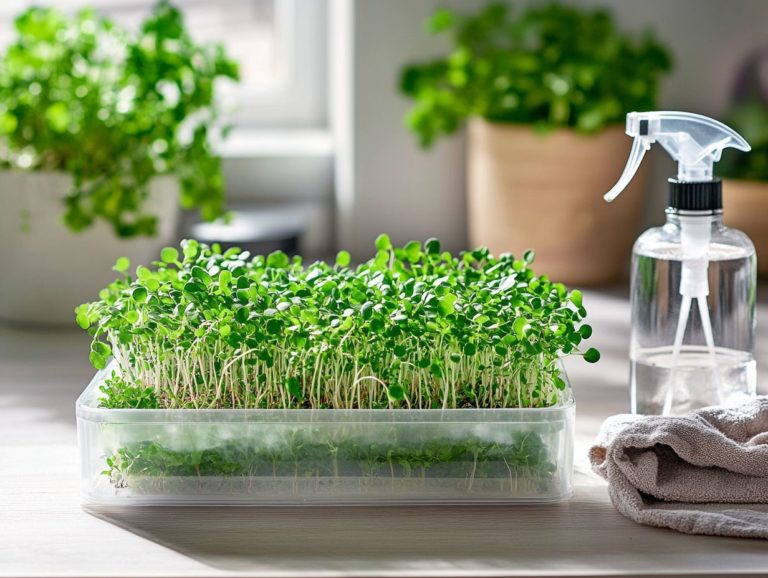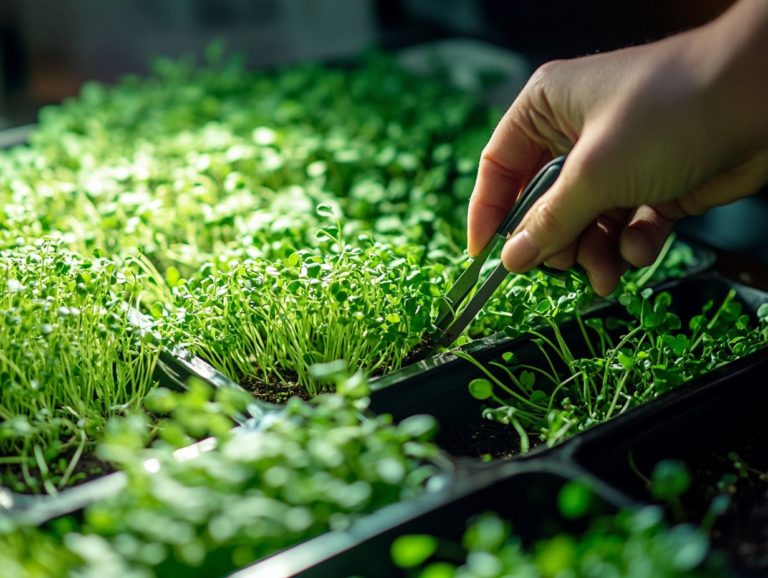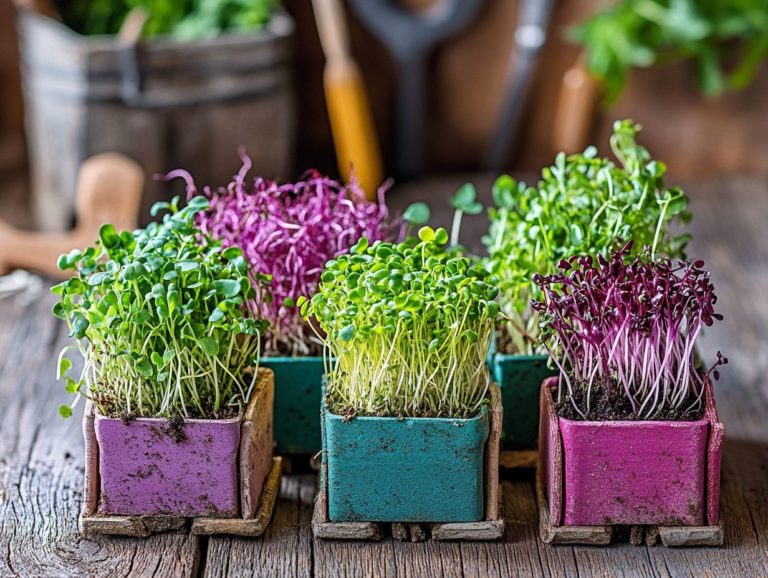5 Tips for Storing Microgreens Long-Term
Storing microgreens with care can greatly enhance their freshness and flavor. This enables you to savor their vibrant taste and nutritional benefits for an extended period. These nutritious treats are increasingly recognized for their health benefits, making them a staple in healthy eating.
Here are five essential tips to ensure your microgreens thrive. We ll cover everything from choosing the right storage containers to creating the perfect storage environment. Get ready to discover answers to your burning questions about microgreens!
Whether you’re a seasoned gardener or just beginning your journey, these tips will empower you to maximize the shelf life of your microgreens.
Contents
- Key Takeaways:
- 1. Choose the Right Container
- 2. Keep Them in a Cool, Dark Place
- 3. Properly Clean and Dry the Microgreens
- 4. Use a Moisture-Absorbing Material
- 5. Regularly Check and Rotate the Microgreens
- How Long Can Microgreens Be Stored?
- Frequently Asked Questions
- What are microgreens and which family do they belong to?
- Why is it important to store microgreens long-term?
- What are the top 5 tips for storing microgreens long-term?
- Why should I use airtight containers for storing microgreens?
- How long can microgreens be stored using these tips?
- Can I store different types of microgreens together?
Key Takeaways:

- Choose a container with good ventilation to store your microgreens long-term.
- Keep your microgreens in a cool, dark place to preserve their freshness.
- Clean and dry your microgreens thoroughly before storing to prevent spoilage.
1. Choose the Right Container
Choosing the right container is essential for storing microgreens. It significantly influences their freshness, shelf life, and nutrient concentration.
Among the various storage options, plastic containers truly shine. They are lightweight and versatile, providing excellent airflow and moisture management.
Different varieties require different considerations. For instance, Brassicaceae family members like cabbage and kale thrive in shallow containers. In contrast, Amaranthaceae varieties, such as amaranth, prefer slightly deeper environments. Meanwhile, members of the Apiaceae family, including carrots and parsley, need a bit more space for robust growth.
When selecting containers, consider not just the size but also the ventilation features. This attention to detail will help you create optimal conditions for each microgreen variety.
2. Keep Them in a Cool, Dark Place
To truly maximize the freshness and nutritional benefits of your microgreens, store them in a cool, dark place. This approach effectively manages gases that can speed up spoilage and moisture content.
Aim for optimal temperature conditions between 32 F and 40 F. This range dramatically slows degradation, ensuring that those delicate flavors and nutrients remain intact.
Humidity is equally important. Moderate humidity prevents wilting and maintains the crispness of your microgreens while avoiding the risk of mold growth.
Steering clear of direct light is crucial. Exposure can accelerate the loss of vital nutrients, particularly those sensitive to light. To further improve your microgreens’ freshness, learn how to store different microgreen varieties. By thoughtfully considering these environmental factors, you can significantly enhance the longevity and healthfulness of your microgreens.
3. Properly Clean and Dry the Microgreens
Properly cleaning and drying microgreens before storage is essential for maintaining their exquisite flavor and texture. This also prevents spoilage from excess moisture that can encourage mold growth.
To begin, gently rinse the microgreens under cool running water. Make sure to remove any soil or debris without bruising those delicate leaves. A colander works wonders here, allowing the water to drain off effectively.
After washing, it’s vital to pat them dry with a clean towel or use a salad spinner. Any lingering moisture can compromise the integrity of these tender greens.
Once cleaned, opt for breathable containers instead of plastic bags. This preserves the ideal humidity balance, keeping your microgreens fresh and vibrant for a longer duration.
This gentle handling is crucial, as it safeguards their delicate structure and elevates your overall culinary experience. To maximize your success, consider following the best practices for indoor microgreens. Start storing your microgreens today to enjoy their full benefits!
4. Use a Moisture-Absorbing Material
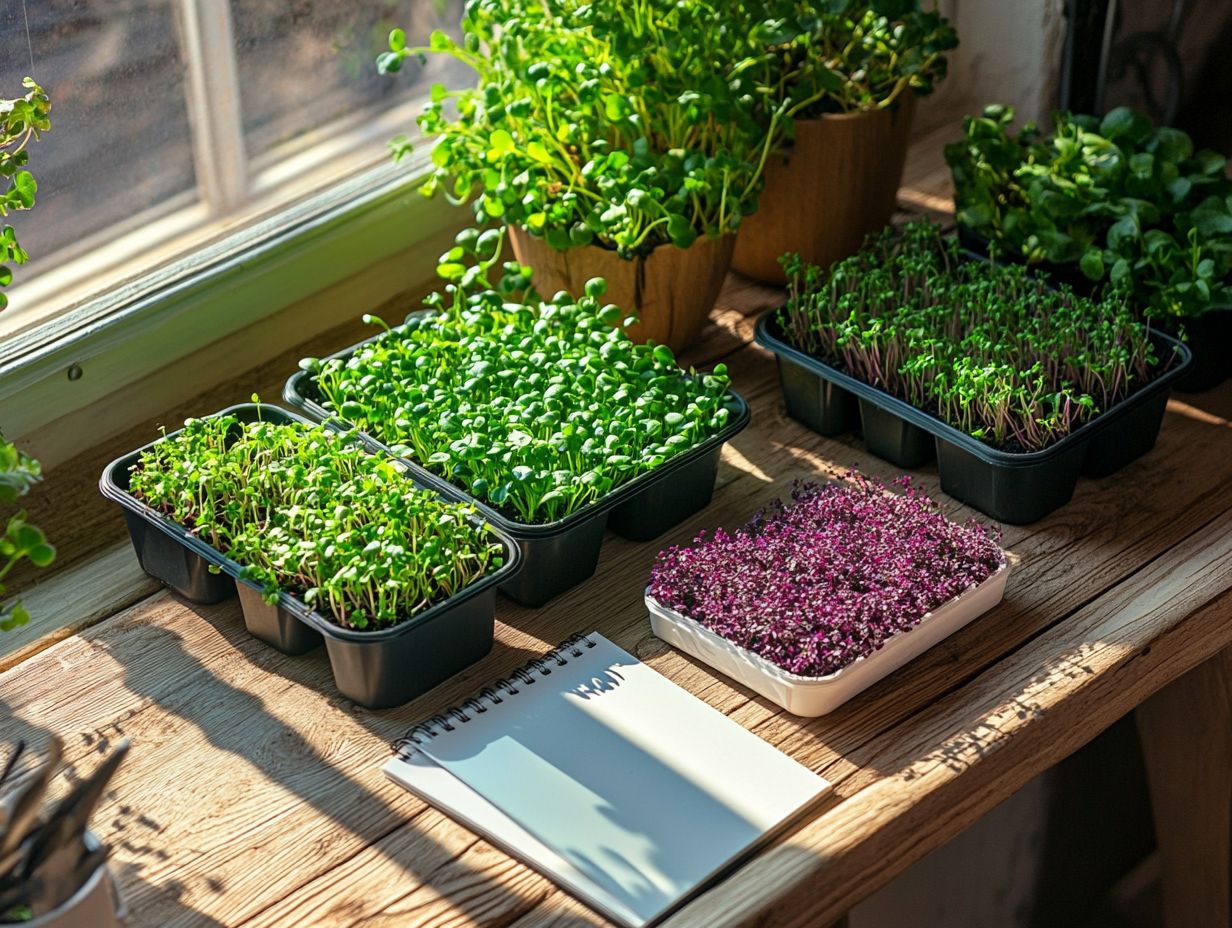
Using a moisture-absorbing material like paper towels in your storage containers can greatly extend the shelf life of your microgreens. This helps manage extra moisture and keeps the ideal storage conditions.
These materials prevent spoilage. Too much moisture can lead to mold growth, which not only makes your microgreens look bad but also reduces their nutrient value. By placing damp microgreens on a layer of paper towels in a breathable container, the towels can effectively absorb any extra moisture. Covering the microgreens with another layer of paper towels creates a moisture-controlling environment, ensuring optimal humidity without water buildup.
This simple method keeps your greens fresh and delicious while preserving their vibrant nutrient profile. Enjoy all the health benefits that microgreens offer!
5. Regularly Check and Rotate the Microgreens
Check and rotate your microgreens regularly to ensure their freshness, flavor, and health benefits. This practice helps each variety stay at its peak quality during storage.
Paying close attention allows you to spot any signs of spoilage or wilting. It also creates an optimal environment for growth. A systematic approach to inspecting your microgreens helps you quickly identify issues like discoloration or sliminess that may indicate spoilage.
For best results in rotating your microgreen varieties, place the older stocks at the front and move the newer ones to the back. This creates a first-in, first-out system. To keep them fresh, lightly hydrate the microgreens before storage and keep them in a cool, dark place. Additionally, learning how to extend the growing season for microgreens can significantly enhance your growing experience. This simple step can significantly extend their shelf life.
How Long Can Microgreens Be Stored?
The shelf life of microgreens can vary based on the variety and how you store them. Understanding these factors helps you maximize their longevity and nutrients, which are essential for fighting diseases like heart disease and diabetes.
For example, greens like arugula and kale usually last about 5 to 7 days if left unrefrigerated. In contrast, sturdier options like radish microgreens can last up to two weeks with proper care. If you’re interested in growing these greens during the colder months, consider following some helpful tips for growing microgreens in winter. It’s crucial to store these nutrient-dense greens in a sealed container in the refrigerator to reduce moisture loss and prevent wilting. Adding paper towels to absorb any excess moisture can enhance their freshness.
By maintaining optimal conditions for your microgreens, you not only extend their shelf life but also enjoy sustained levels of vitamins and minerals vital for a healthy diet.
What Are the Best Types of Containers for Storing Microgreens?
Choosing the right containers for storing microgreens can greatly enhance their freshness and nutritional quality. Plastic containers offer excellent air flow and moisture management.
These containers promote air flow and help maintain necessary moisture levels, which are crucial for the health of various microgreen varieties. When selecting containers, consider the specific needs of different microgreen families.
Robust types like sunflowers benefit from deeper containers to accommodate their root systems, while delicate varieties like basil thrive in shallower ones.
Understanding these needs can lead to superior growth, sustainability, and improved flavor in every harvest.
Have you tried these methods? Share your experiences!
How Can You Tell If Microgreens Are Spoiled?

Identifying spoiled microgreens is essential for preserving their health benefits and reducing food waste. Look out for common signs like wilting, discoloration, and any unpleasant odors. These odors are often intensified by a gas that some fruits and vegetables release, which speeds up spoilage.
To keep your microgreens looking vibrant and packed with nutrition, pay attention to their texture. Sliminess can signal spoilage. Fresh microgreens should feel crisp when you touch them, while any mushiness indicates they re starting to decompose.
Keep in mind that ethylene can quickly spoil your greens! To counteract this, store your microgreens away from ethylene-producing items and consider using airtight packaging to create an environment that slows down deterioration. For even better results, check out how to maximize yields from microgreens. By routinely checking for these indicators, you can help maintain their freshness and extend their shelf life.
Harvesting Microgreens: Tips for Maximum Freshness!
Implementing best practices for harvesting microgreens is essential to preserving their delightful flavor and vital nutrients. Use techniques that involve cutting microgreens with precision and gentle handling throughout the process to ensure they remain nutrient-rich.
For optimal results, it’s crucial to harvest microgreens at just the right moment typically when the first true leaves have developed. This showcases vibrant colors and robust growth. Using sharp, clean scissors or a knife allows for a clean cut, minimizing any damage to the delicate stems and leaves.
Once you’ve made the cut, handle them gently to preserve nutrients and avoid bruising, which can compromise their freshness. Additionally, be aware of the top 5 mistakes in growing microgreens to ensure optimal quality. Storing your microgreens in breathable containers can extend their shelf life, ensuring you maintain the crispness and taste that make them a culinary favorite.
The Benefits of Long-Term Storage for Microgreens
Storing microgreens long-term presents a wealth of benefits, including unparalleled convenience for maintaining a healthy diet. You can ensure a steady supply of these nutritious treats brimming with vitamins, minerals, and antioxidants.
This method allows you to savor the vibrant flavors and textures of fresh greens whenever you desire. It also plays a crucial role in reducing food waste in urban food deserts. By employing effective storage techniques, you can easily preserve the freshness of these tiny powerhouses, minimizing spoilage and maximizing your nutritional intake.
Instead of frequently buying fresh produce that risks wilting in your fridge, rely on your carefully stored microgreens. You can seamlessly incorporate them into your meals while enjoying their continuous health benefits. Embracing long-term storage by learning techniques for growing microgreens year-round supports your personal wellness and fosters more sustainable eating habits.
Effective Methods for Storing Microgreens
There are several methods for storing microgreens, each crafted to optimize moisture management and preserve their nutrients. This ensures that you reap the health benefits of these superfoods, which are packed with nutrients and antioxidants.
To start, consider using breathable containers like perforated bags. These help regulate humidity levels, keeping excess moisture at bay to prevent spoilage. Placing your microgreens on paper towels before sealing them can absorb any extra moisture while still allowing for air circulation. For more insights, check out 5 tips for successful microgreen germination.
Another effective technique is to use airtight containers to maximize freshness. Don’t forget to include a small desiccant pack for moisture control. Keeping your microgreens in a refrigerator set between 34 F and 40 F will significantly enhance their shelf life. Regularly check for signs of wilting to ensure they stay fresh and loaded with essential nutrients. For additional guidance, consider following these essential tips for growing microgreens at home.
Frequently Asked Questions
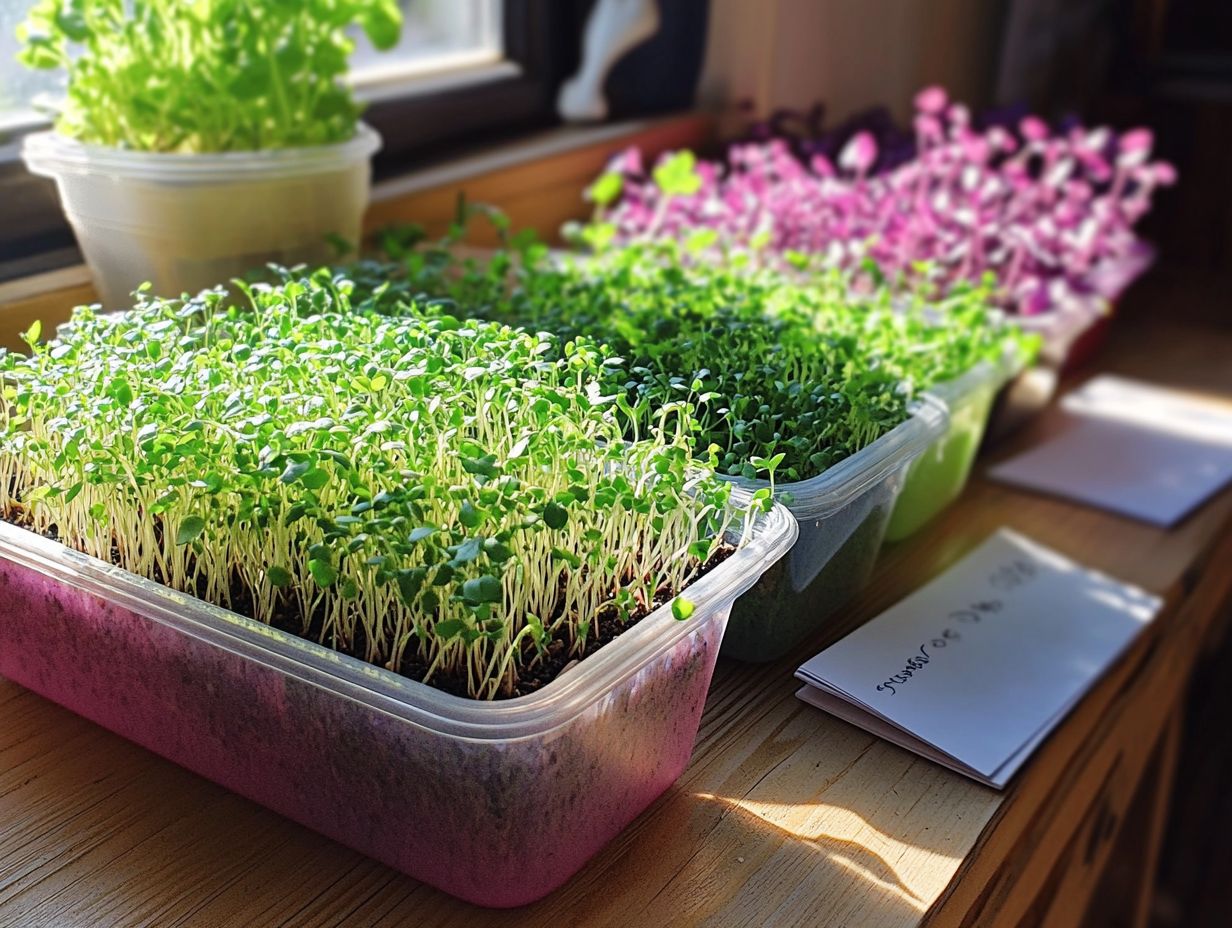
What are microgreens and which family do they belong to?
Microgreens are young vegetable greens harvested just after the first leaves appear. They re full of nutrients and add great flavor and texture to dishes.
Why is it important to store microgreens long-term?
Storing microgreens long-term allows you to enjoy them even when they re out of season. It reduces food waste and saves money.
What are the top 5 tips for storing microgreens long-term?
- Use airtight containers.
- Store them in the fridge.
- Keep them dry.
- Change the paper towel regularly.
- Label and date your containers.
Why should I use airtight containers for storing microgreens?
Airtight containers keep moisture out. This prevents microgreens from wilting and helps maintain their freshness and flavor.
How long can microgreens be stored using these tips?
With proper storage, microgreens can last up to 10 days in the fridge. Some varieties might last even longer due to their toughness.
Can I store different types of microgreens together?
It s best to store different varieties separately. This prevents mixing flavors and moisture, keeping each type fresh.




